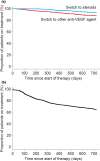Treatment patterns and persistence rates with anti-vascular endothelial growth factor treatment for diabetic macular oedema in the UK: A real-world study
- PMID: 34796985
- PMCID: PMC9299692
- DOI: 10.1111/dme.14746
Treatment patterns and persistence rates with anti-vascular endothelial growth factor treatment for diabetic macular oedema in the UK: A real-world study
Abstract
Introduction: Anti-vascular endothelial growth factors (anti-VEGFs) are considered standard of care therapy for diabetic macular oedema (DME). This study examined treatment patterns and outcomes in patients with DME treated with anti-VEGF therapy.
Methods: Using anonymized electronic medical record data collected from three UK sites, this retrospective cohort study assessed rates of anti-VEGF intravitreal injections in adults with treatment-naïve DME who received their first treatment between 1 September 2010 and 31 July 2018. The proportion of patients with at least one interval of at least 12 weeks between injections; the distribution of injection intervals; the discontinuation rates; and the number of anti-VEGF injection-, injection-free- and total visits were assessed during the first and second years of treatment.
Results: Overall, 1606 patient eyes with DME were included, with no minimum follow-up. During the first and second year of treatment, 63.2% and 73.1% of eyes had at least one anti-VEGF injection interval of at least 12 weeks, respectively. In the first and second years of treatment, the mean (standard deviation) numbers of injections were 7.7 (1.9) and 5.6 (2.2), with 14.2 (5.7) and 13.4 (6.4) total clinic visits, and 6.6 (5.0) and 7.8 (5.8) injection-free visits, respectively. In total, 27.8% of patient eyes discontinued treatment during the first 2 years.
Conclusions: The high number of clinic visits and high discontinuation rates demonstrate a significant unmet need for a treatment to enable sustainable extended injection intervals, while maintaining visual acuity. This could improve patient adherence and health-related quality of life for patients with DME.
Keywords: DME; anti-VEGF; health care delivery.
© 2021 Novartis Pharma AG. Diabetic Medicine published by John Wiley & Sons Ltd on behalf of Diabetes UK.
Conflict of interest statement
T.P. has received honoraria and speaker's fees from Bayer and Novartis. T.A. and U.C. have received honoraria and travel support from Bayer and Novartis. A.S. and A.C. are employees and shareholders of Novartis. S.Z. is an employee of IQVIA, which received funding from Novartis Pharma AG for the conduct of this study.
Figures



References
-
- Diabetes UK . Diabetes prevalence 2019. 2019. Accessed January 19, 2021. https://www.diabetes.org.uk/professionals/position‐statements‐reports/st...
-
- Klein R, Moss SE, Klein BE, Davis MD, DeMets DL. The Wisconsin epidemiologic study of diabetic retinopathy. XI. The incidence of macular edema. Ophthalmology. 1989;96(10):1501‐1510. - PubMed
-
- Ciulla TA, Amador AG, Zinman B. Diabetic retinopathy and diabetic macular edema: pathophysiology, screening, and novel therapies. Diabetes Care. 2003;26(9):2653‐2664. - PubMed
-
- Rubino A, Rousculp MD, Davis K, Wang J, Girach A. Diagnosed diabetic retinopathy in France, Italy, Spain, and the United Kingdom. Prim Care Diabetes. 2007;1(2):75‐80. - PubMed
Publication types
MeSH terms
Substances
LinkOut - more resources
Full Text Sources
Medical

